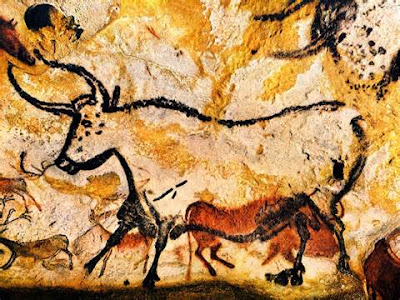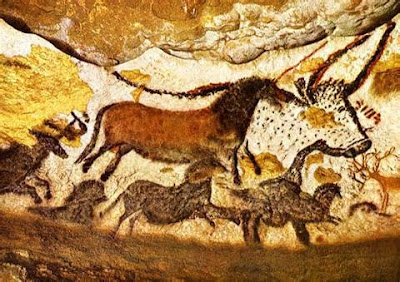I have been trying for a while now to find a pictograph or petroglyph of a human, animal, or other object, that also includes a representation of the shadow of that human, animal, or object. Why are there no representations of shadows in rock art? Shadows are certainly important in rock art. Shadows produce the pointers in archeoastronomy calendar sites. Shadows allow us to see faint rock art under certain conditions of lighting, and shadows from low-angle side lighting allow us to clearly see shallow petroglyphs. I cannot, however, find a convincing example of a shadow included in a rock art portrayal, in other words the image of a shadow in a pictograph or petroglyph.
There are, however, many instances where the artists of Paleolithic European painted caves incorporated shadows in their work. I find it fascinating that so many of the animals portrayed on the walls of painted caves in Europe are shown standing with their feet right at a breaking point in the slope of the wall, so that with a light source held up they are standing on a shadow.
In an
interesting essay on the philosophy of shadows Roy Sorensen wrote about eights
century monk Fridugisus of Tours who read the bible to prove the existence of
shadows when he could see the shadows on the page. Sorensen commented: “I do not trust my eyes! Instead of reading
between the lines of divine testimony, I read between the lines of scientific
testimony. I ask: Do astronomers presuppose the existence of shadows when they
calculate the altitude of lunar mountains? Do physicists imply that shadows
move when the measure waves in a ‘shadow tank’? (The tank is filled with
transparent water!)” (Sorensen 2021) (Our Paleolithic artists would have
seen this effect where bright sunshine shone onto the bottom of a stream or
pond through ripples in shallow water – a natural shadow tank. I would bet that
they noticed it as well, but did they try to analyze it?)
Sorensen’s basic question is then, do shadows really exist? Shadows are the absence of light, does the absence of something here indicate the existence of something else? In this we are dependent on our own basic senses. “Shadows were fringe phenomena in the Dark Ages. They are rarely depicted in the era’s paintings. Perhaps the artists portrayed only what they believed to be visible. In De Anima, Aristotle writes that each sense has its own proper object: ‘Sight has color, hearing sound, taste flavor.’ Color requires light. No light, no sight. That is why we cannot see in the dark! The negative metaphysician takes exception. In a blackout, you do not hear the darkness or taste the darkness. You see the darkness. It even looks a certain way: dark all over, not red all over. You must inform a blind companion of the darkness. For a blind person cannot see the darkness. It no more looks dark to them than it looks dark behind your head. To see the darkness behind your head, you must turn around.” (Sorensen 2021)
Then
Sorensen goes on to discuss the reality (or not) of shadows. “To see is to see light. Shadows cannot
absorb light. Any light present in a shadow is pollution. For a shadow is an
absence of light. Absences of light cannot block light. Metaphysicians who
think reality is always positive deny the visibility of shadows. We see only
light, they say. A shadow is a hole in the light, not a part of what is seen,
they say.” (Sorensen 2021) Were the painters in the great decorated caves
of Europe Positive Metaphysicians who believed that shadows did not exist?
On a relatively uneven cave wall any projection would also cast a shadow from an elevated light source. Perhaps the cave artists did not bother painting shadows because they were counting on the real thing being seen, produced by a light source like a flaming torch held high.
I do not think of the creators of this art as Metaphysicians at all, whether positive or negative. They were practical Opticians who used the effects of light that they could observe to produce the effects they sought in their portrayals. They did not need to paint shadows under their aurochs, horses, mammoths, etc. They could use the real shadows produced by a higher light source and a change in the angle of the wall of the cave to give the image a real shadow – if shadows are real.
If you can find an example of a shadow painted or pecked into a rock art image please send it to me. This could go on a while longer.
NOTE Images in this posting were retrieved from the internet with a search for public domain photographs. If any of these images are not intended to be public domain, I apologize, and will happily provide the picture credits if the owner will contact me with them. For further information on this you should read the original report at the sites listed below.
REFERENCE:
Sorensen, Roy, 2021, Do We Actually See Shadows?, 1 December 2021,
https://daily.jstor.org/











No comments:
Post a Comment